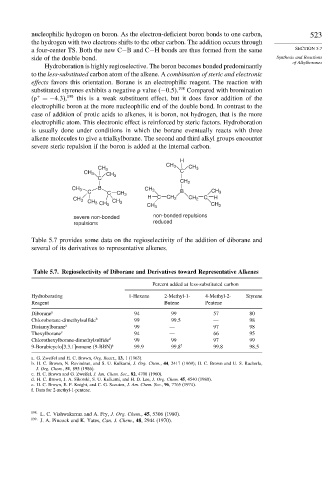Page 542 - Advanced Organic Chemistry Part A - Structure and Mechanisms, 5th ed (2007) - Carey _ Sundberg
P. 542
nucleophilic hydrogen on boron. As the electron-deficient boron bonds to one carbon, 523
the hydrogen with two electrons shifts to the other carbon. The addition occurs through
a four-center TS. Both the new C−B and C−H bonds are thus formed from the same SECTION 5.7
side of the double bond. Synthesis and Reactions
of Alkylboranes
Hydroboration is highly regioselective. The boron becomes bonded predominantly
to the less-substituted carbon atom of the alkene. A combination of steric and electronic
effects favors this orientation. Borane is an electrophilic reagent. The reaction with
substituted styrenes exhibits a negative
value (−0 5). 198 Compared with bromination
+
(
=−4 3), 199 this is a weak substituent effect, but it does favor addition of the
electrophilic boron at the more nucleophilic end of the double bond. In contrast to the
case of addition of protic acids to alkenes, it is boron, not hydrogen, that is the more
electrophilic atom. This electronic effect is reinforced by steric factors. Hydroboration
is usually done under conditions in which the borane eventually reacts with three
alkene molecules to give a trialkylborane. The second and third alkyl groups encounter
severe steric repulsion if the boron is added at the internal carbon.
H
CH 3
CH 3 C CH 3
CH 3
CH 3
C
CH 2
CH 3 B CH 3
C C CH 3 B CH 3
H C CH 2 C H
CH 3 CH 2
CH 3
CH 3 CH 3
CH 3
CH 3
severe non-bonded non-bonded repulsions
repulsions reduced
Table 5.7 provides some data on the regioselectivity of the addition of diborane and
several of its derivatives to representative alkenes.
Table 5.7. Regioselectivity of Diborane and Derivatives toward Representative Alkenes
Percent added at less-substituted carbon
Hydroborating 1-Hexene 2-Methyl-1- 4-Methyl-2- Styrene
Reagent Butene Pentene
Diborane a 94 99 57 80
Chloroborane-dimethylsulfide b 99 99 5 — 98
Disiamylborane a 99 — 97 98
Thexylborane c 94 — 66 95
Chlorothexylborane-dimethylsulfide d 99 99 97 99
9-Borabicyclo[3.3.1]nonane (9-BBN) e 99 9 99 8 f 99 8 98 5
a. G. Zweifel and H. C. Brown, Org. React., 13, 1 (1963).
b. H. C. Brown, N. Ravindran, and S. U. Kulkarni, J. Org. Chem., 44, 2417 (1969); H. C. Brown and U. S. Racherla,
J. Org. Chem., 51, 895 (1986).
c. H. C. Brown and G. Zweifel, J. Am. Chem. Soc., 82, 4708 (1960).
d. H. C. Brown, J. A. Sikorski, S. U. Kulkarni, and H. D. Lee, J. Org. Chem. 45, 4540 (1980).
e. H. C. Brown, E. F. Knight, and C. G. Scouten, J. Am. Chem. Soc., 96, 7765 (1974).
f. Data for 2-methyl-1-pentene.
198 L. C. Vishwakarma and A. Fry, J. Org. Chem., 45, 5306 (1980).
199
J. A. Pincock and K. Yates, Can. J. Chem., 48, 2944 (1970).

